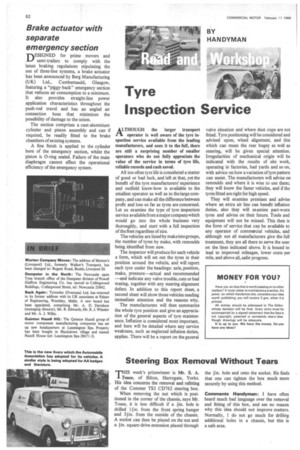Tyre Inspection Service
Page 54

If you've noticed an error in this article please click here to report it so we can fix it.
A.THOUGH the larger transport operator is well aware of the tyre inspection service available from the leading manufacturers, and uses it to the full, there are still a surprising number of smaller operators who do not fully appreciate the value of the service in terms of tyre life, reliable records and cash saved.
All too often tyre life is considered a matter of good or bad luck, and left at that, yet the benefit of the tyre manufacturers' experience and outfield know-how is available to the smallest operator as well as to the large company, and can make all the difference between profit and loss so far as tyres are concerned. Let us examine the type of tyre inspection service available from a major c omp any which would go into the whole business very thoroughly, and start with a full inspection of the fleet regardless of size.
The vehicles are listed by make into groups, the number of tyres by make, with remoulds being identified from new.
The inspector will produce for each vehicle a form, which will set out the tyres in their position around the vehicle, and will report each tyre under the headings: axle, position, make, pressure—actual and recommended —and indicate any valve trouble, cuts or bad mating, together with any steering alignment defect. In addition to this report sheet, a second sheet will show those vehicles needing immediate attention and the reasons why.
The manufacturers will then summarize the whole tyre position and give an appreciation of the general aspects of tyre maintenance. Inflation is considered most important, and here will be detailed where any service weakness, such as neglected inflation duties, applies. There will be a report on the general valve situation and where dust cups are not fitted. Tyre positioning will be considered and advised upon, wheel alignment, and this which can mean the rear bogey as well as steering, will be given special attention. Irregularities of mechanical origin will be indicated with the results of site work, operating in factories, bad yards and so on, with advice on how a variation of tyre pattern can assist. The manufacturers will advise on remoulds and where it is wise to use them; they will know the faster vehicles, and if the tyres fitted are right for high speed.
They will examine premises and advise where an extra air line can benefit inflation duties, also they will examine part-worn tyres and advise on their future. Tools and equipment will not be missed. This then is the form of service that can be available to any operator of commercial vehicles, and although not all manufacturers give the full treatment, they are all there to serve the user on the lines indicated above. It is bound to lead to improved mileages, lower costs per mile, and above all, safer progress.




























































































































